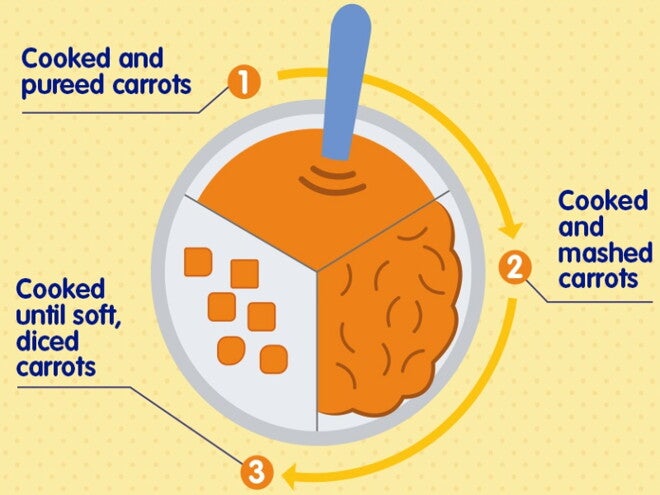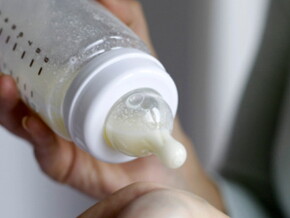
Your step-by-step guide to texture
Your step-by-step guide to texture
Once your baby has mastered smooth purees, it’s time to offer textured foods. Experience with different textures helps them develop the skills for chewing. Here’s how you might adapt foods from four main food groups.
From puree to pieces, your baby is on a journey of new discoveries. Here are some ideas to give your baby different textures to taste:

Sources
Nicklaus S, Demonteil L, Tournier C. Modifying the texture of foods for infants and children. In: Modifying Food Texture, Volume 2. Elsevier, 2015: 187-222.
Nicklaus S. Complementary feeding strategies to facilitate acceptance of fruits and vegetables: A narrative review of the literature. Int J Environ Res Public Health 2016; 13(11): 1160; doi:10.3390/ijerph13111160
World Health Organization. Infant and young child feeding: Model chapter for textbooks for medical students and allied health professionals. Geneva, World Health Organization, 2009.
Related articles

Baby Solids: Guide & planning pour bébé de 8 mois.
Around the six-month mark, your baby will probably show signs of being ready for bites of their first food.
6 mins to read

How to Switch From Breastfeeding to Bottle-feeding
Whether you want to express breast milk or you’re thinking of supplementing with baby formula, try these 13 tips on how to switch from breastfeeding to bottle-feeding.
7 mins to read

Infant nutrition needs: 6-8 months
As your baby reaches 6-8 months old, some vitamins and minerals are especially important for their health.
4 mins to read

How to prepare and store baby formula
Formula. It’s full of nutrition—but how you prep and store it can serve up some questions, too.
5 mins to read

Benefits of probiotics for babies
This article includes contributions from Dr. Dina Kulik, pediatrician, and Charlotte Geroudet, GD.
5 mins to read

Did you know?
Around six months of age, baby’s evolving needs call for the introduction of foods
1 min to read

How to strengthen your baby's immune system
By Dr. Ted Jablonski, family physician
3 mins to read

The ins and outs of babies’ digestive system
By Dr. Jeff Habert, family physician
3 mins to read

Food Allergies in Babies
There is growing evidence that many factors in the environment play a role in allergies developing in babies.
3 mins to read

Baby Feeding and Nutrition: The Guide
How will you feed your newborn?
7 mins to read

Did you know?
The way young children are fed may be as important as the food offered
1 min to read

Safe first finger food for babies
By now you've noticed that everything seems to make its way into your little one’s mouth. Once he’s able grasp small objects, eating those little goodies is exactly what he'll try to do.
5 mins to read

How to Choose & Introduce Formula to Your Baby
Choosing and introducing a baby formula can be a difficult decision for any parent.
5 mins to read

3 tips for your baby’s happy, healthy tummy
By Dr. Ted Jablonski, family physician
3 mins to read

How to Switch Formulas
Your baby’s growing and their digestive system is developing, too. Learn how to switch formulas the right way to support your child’s nutritional needs.
3 mins to read

The importance of responsive feeding for lifelong health
Did you know? Both pressuring your baby to eat more, or restricting how much they eats, can interfere with their growth.
2 mins to read

Food allergies: advice you need to know
Recent research on food allergies has led to new recommendations for the introduction of commonly allergenic foods once babies start eating solid food. Confused?
5 mins to read

Getting started: traditional and baby-led weaning
Your baby may be developmentally ready to start complementary feeding at around six months of age, when they are able to hold their head up and sit in a high-chair.
3 mins to read

10 ways to introduce variety and texture
Help your six- to eight-month-old grow up to be a healthy eater by offering a wide variety of flavours and textures now.
6 mins to read


